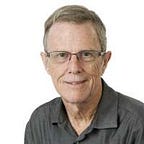Lacing up the Silver Sneakers
I stood behind a straight-back chair, my arms hanging loosely at my sides. I wore gray sweatpants, a black T-shirt and well-worn Nikes. Arranged on and around the chair were a pair of dumbbells, an elastic cord with plastic handles on each end, and an inflated ball, slightly smaller than a volleyball.
Over the next hour I would use these objects, along with my creaky, 65-year-old body, in the Silver Sneakers Circuit class for “seniors/active older adults” at the YMCA in downtown Houston. Led by a personal trainer wearing a headset, we stretched, bent, squatted, clapped, marched in place, arm-pumped, side-stepped, rolled and twisted to the accompaniment of pop tunes, many from the era when we were young. (I heard “Sunny,” by Bobby Hebb, for the first time in decades.)
This was a popular class, perhaps 40 people. I counted five men scattered among the ladies. My girlfriend, Ruth Ann, stood in front of me; to her left was a woman who looked to be about 80, wearing a T-shirt that commanded “Vote!” in English, Spanish, Vietnamese and Chinese. She mouthed the lyrics to some of the songs as she swung her arms and arched her back and splayed her legs. Her face radiated joy.
This class was a departure from my usual, solitary exercise rituals. At the gym, my routine is two sets of 10 reps each on various weight machines, followed by 45 minutes on the treadmill. I also took up cycling about five years ago, and I try to ride three or four times a week, weather permitting.
Ruth Ann, who attends classes like this one regularly, had encouraged me to try it. At first I felt a bit sheepish, bouncing around clumsily in the midst of all these strangers. But this feeling soon passed as it became clear that many of the others were just as clueless as I was, and no one cared if I wasn’t doing a particular exercise correctly. The point was to move around, get our heart rates up, perhaps tone some muscles and improve our balance and posture. It turned out to be quite a vigorous workout.
But something else was at work here. By moving our bodies in a shared space, we “active older adults” were making a statement: We’re not invisible. We’re still here. We still matter. For me, it was a timely message.
My transition from a middle-aged guy to a senior citizen — or worse, simply “senior,” a term that should be reserved for students in their final year of high school or college — seems to have transpired while I wasn’t paying attention. Suddenly I was getting discounts for movie tickets without even asking. I was having trouble seeing the lines on the pavement when I drove at night. And at work, in the year or so before my recent retirement, I found myself getting annoyed at certain comments posted on social media by younger colleagues. They thought it was “cute” or “adorable” that people their parents’ age — that is, my age — were enjoying intimate relationships or using technology more recent than an abacus.
These things used to be measured differently. The notion that large numbers of people over 60 could enjoy robust, active lives is relatively recent; among my grandparents’ cohort, most of those who made it this far expected little more than pureed food, wheelchairs and adult diapers. The photos in AARP publications showing happy 75-year-olds gliding across dance floors, dining on elegant cruise ships or leaping around in exercise classes would have seemed like a fantasy to them.
I’m not convinced our culture has fully adapted to these new opportunities in life’s final stanzas.
At the end of the Circuit class, another instructor took over for a few minutes of gentler activities: breathing, relaxing, meditating. She told us to open our chests, breathe deeply in through our noses and out through our mouths. If we relaxed our faces, she said, the rest of our body would tend to relax as well. (This actually worked. Who knew?)
For meditation, she asked us to imagine the words “I am” as we breathed in, and then finish this thought in various ways as we breathed out. (“I am . . . a father.” “I am . . . a friend.” “I am . . a human being.”) The idea was to practice self-affirmation. This kind of stuff is usually a bit touchy-feely for me, but perhaps the exercise had put me into a frame of mind where I could appreciate it. I found myself reminded of a poem often recited by civil rights leader Jesse Jackson that includes these words: “I am (pause) somebody. My mind (pause) is a pearl.”
It’s a fine theme for a workout. Or for those of us enjoying life’s unexpected bonus round.
